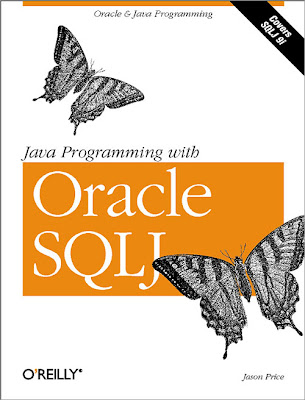
Jason Price
Publisher: O'Reilly
First Edition August 2001
ISBN: 0-596-00087-1, 398 pages
Start Reading
SQLJ lets you access an Oracle database from a Java program and is much easier to use than the alternative, JDBC. Java Programming with Oracle SQLJ moves from the basics of getting connected and issuing SQL statements all the way to advanced topics such as streams and multithreading. You'll learn not just how to use SQLJ, but how to leverage it for all it's worth.
Preface
Audience
Organization
About the Examples
Software and Versions
Conventions Used in This Book
Comments and Questions
Acknowledgments
1. Introduction
1.1 Comparing SQLJ and JDBC
1.2 SQLJ Components
1.3 Requirements for Using SQLJ
1.4 Configuring Your Environment
1.5 A "Hello World" Program for SQLJ
1.6 The sqlj Command-Line Utility
1.7 Oracle JDeveloper
2. Relational Databases, SQL, and PL/SQL
2.1 Relational Databases
2.2 Structured Query Language (SQL)
2.3 PL/SQL
3. Fundamental SQLJ Programming
3.1 SQLJ Programs
3.2 Database Connections
3.3 Simple SQLJ Statements
3.4 Transactions
3.5 Queries That Return Multiple Rows
3.6 Nested Cursors
3.7 PL/SQL in SQLJ
4. Database Objects
4.1 Defining Object Types
4.2 Object Columns and Object Tables
4.3 Creating Custom Classes
4.4 Accessing Database Objects Using SQLJ
4.5 Object Identifiers and REF Columns
5. Collections
5.1 VARRAYs
5.2 Nested Tables
5.3 Storing an Object Type in a Collection
5.4 Collection Custom Classes
5.5 Accessing Collections Using SQLJ
6. Deploying SQLJ in the JServer
6.1 Understanding the Oracle JServer
6.2 Designing Server-Based SQLJ Programs
6.3 Translating SQLJ Programs
6.4 Loading SQLJ Programs into the Database
6.5 Publishing Class Methods
6.6 Using Database Triggers
6.7 Using JDeveloper to Translate and Load SQLJ Programs
6.8 Using Enterprise JavaBeans
7. Large Objects
7.1 The Example Files and Directories
7.2 Large Objects (LOBs)
7.3 LONG and LONG RAW Columns
8. Contexts and Multithreading
8.1 Connection Contexts
8.2 Execution Contexts
8.3 Multithreaded SQLJ Programs
9. Advanced Transaction Control
9.1 Transaction Processing Problems
9.2 Transaction Isolation Levels
9.3 The SET TRANSACTION Statement
9.4 A Transaction Isolation Level Example
10. Performance Tuning
10.1 Row Prefetching
10.2 Batch Processing
10.3 Tuning SQL Statements
10.4 The Oracle Optimizer
11. Combining JDBC, SQLJ, and Dynamic SQL
11.1 Static and Dynamic SQL
11.2 Sharing Database Connections
11.3 SQLJ Iterators and JDBC Result Sets
A. Java and Oracle Type Mappings
A.1 JDBC 1.x Type Mappings
A.2 Additional JDBC 2.0 Type Mappings
A.3 Java Wrapper Class Mappings
A.4 SQLJ Stream Class Mappings
A.5 Oracle Extension Class Mappings
B. Oracle Java Utilities Reference
B.1 Oracle SQLJ Translator
B.2 JPublisher
B.3 loadjava
B.4 dropjava
B.5 deployejb
C. SQLJ in Applets, Servlets, and JavaServer Pages
C.1 SQLJ in Applets
C.2 SQLJ in Servlets
C.3 SQLJ in JavaServer Pages
Colophon
Download
Another Database Books
No comments:
Post a Comment